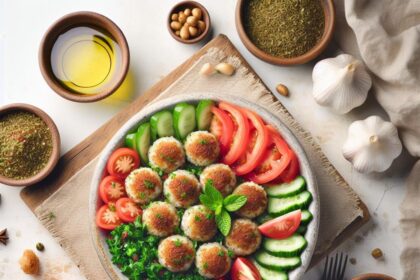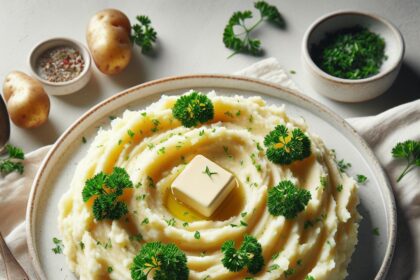There’s nothing quite as frustrating as peeling and slicing a batch of potatoes, only to watch them turn an unappetizing shade of brown before you even get a chance to cook. Browning is the enemy of freshness, stealing away that crisp, clean look and making your potatoes appear tired and less inviting. But fear not-keeping cut potatoes fresh doesn’t have to be a battle against time and oxidation. With a few clever tricks up your sleeve, you can preserve their bright, vibrant appeal and enjoy perfectly fresh potatoes whenever you’re ready to cook. Dive in as we explore simple, effective tips to stop your cut potatoes from browning fast and keep them looking fresh long after the peel hits the cutting board.
Keep Cut Potatoes Fresh: Tips to Prevent Browning Fast
Understanding why potatoes brown quickly after cutting is the first step to mastering freshness in your kitchen. When potatoes are sliced or peeled, their cells release enzymes that react with oxygen, causing that unappealing brown color. With the right soaking techniques and storage methods, you can keep cut potatoes crisp and vibrant, ensuring each dish shines with natural beauty and flavor.
Prep and Cook Time
- Preparation: 10 minutes
- Soaking: 15-30 minutes
- Cook Time: Varies by recipe
Yield
- Serves 4-6 as a side dish or part of your recipe
Difficulty Level
- Easy – Perfect for beginners and seasoned cooks alike
Ingredients
- 4 medium potatoes, peeled and cut to desired shape
- 4 cups cold water (for soaking)
- 1 tablespoon white vinegar or lemon juice
- 1 teaspoon salt
- Optional: 1 teaspoon ascorbic acid powder (vitamin C) or sodium metabisulfite
Instructions
- Immediately place cut potatoes into a bowl of cold water. Fresh, cold water slows down the enzymatic browning triggered by oxygen exposure.
- Add white vinegar or lemon juice to the water. The acidity lowers the pH on the potato surface, effectively preventing the browning enzyme from activating.
- Sprinkle salt into the soaking water to help maintain the texture by preventing cut surfaces from becoming mushy over extended soak times.
- Soak for at least 15 minutes and up to 30 minutes, depending on how long you wish to preserve the cut potatoes before cooking.
- Drain thoroughly and pat dry with paper towels before cooking or storing. This step prevents sogginess and promotes even cooking.
- If storing for longer than a few hours, transfer the potatoes to an airtight container filled with fresh cold water, adding a splash of lemon juice to maintain freshness.
- For best results, cook potatoes within 24 hours of cutting; if browning has started despite precautions, blanching in boiling water for 2 minutes before storing can also help rejuvenate their appearance and texture.
Chef’s Notes: Mastering the Art of Fresh Potatoes
Adding ascorbic acid or commercial anti-browning agents provides a powerful natural remedy for extending freshness-ideal for batch prepping fries or salads. Remember, the key is minimizing air exposure; even the best soaking technique needs airtight storage post-soak.
While vinegar is excellent for white potatoes, be cautious when soaking sweet potatoes, as their flavor profile reacts differently. For variety, try soaking the cut potatoes in cold water with a hint of rosemary or garlic for subtle aromatics before cooking!
Serving Suggestions: Celebrate Freshness
After ensuring your potatoes remain pint-size, golden, and fresh, serve them tossed with herb butter or roasted alongside garlic and thyme for a rustic charm. Garnish with chopped parsley or chives to add a bright, fresh contrast to the earthy flavors.
For a visually stunning presentation, combine differently cut potato shapes, like wedges and matchsticks, perfectly preserved with these soaking and storage secrets. The contrast in textures will impress any guest or family member.
| Nutrient | Per 100g Potato |
|---|---|
| Calories | 77 kcal |
| Protein | 2 g |
| Carbohydrates | 17 g |
| Fat | 0.1 g |

For a deep dive into cooking perfect potatoes every time, visit our Potato Cooking Guide or explore the scientific basics of enzymatic browning on ScienceDaily.
Q&A
Q&A: Keep Cut Potatoes Fresh – Tips to Prevent Browning Fast
Q1: Why do cut potatoes turn brown so quickly?
A1: When you slice or chop potatoes, you break their cells, exposing enzymes called polyphenol oxidase to oxygen. This triggers a chemical reaction known as enzymatic browning, which causes those unsettling brown spots to appear. It’s nature’s way of telling you the potato is oxidizing!
Q2: Can I stop potatoes from browning completely?
A2: While you can’t stop oxidation entirely without special preservatives, you can definitely slow it down. The key is to limit oxygen exposure and slow the enzyme activity by soaking, refrigerating, or acidifying the potatoes.
Q3: What’s the simplest kitchen trick to keep cut potatoes looking fresh?
A3: Soak them in cold water! Submerging cut potatoes in cold water creates a barrier between the potato surface and oxygen, drastically slowing browning. Plus, a splash of ice-cold water gives them a crisp texture boost.
Q4: Are there any special ingredients that help keep cut potatoes fresh?
A4: Absolutely! Adding a bit of lemon juice or white vinegar to the soaking water introduces acid, which inhibits the browning enzymes. Just a tablespoon per quart of water can make a noticeable difference.
Q5: Is refrigeration necessary after cutting potatoes?
A5: Yes, chilling cut potatoes slows down enzymatic activity and keeps them fresh longer. Just keep them submerged in water in an airtight container to prevent them from picking up fridge odors or drying out.
Q6: Can salt or other seasonings affect browning?
A6: Salt in the soaking water can help reduce browning by drawing out some surface starch and reducing enzyme activity. However, avoid heavily seasoning potatoes before cooking, as salt can affect texture if left too long.
Q7: How long can cut potatoes be stored using these methods?
A7: When stored submerged in cold, acidified water in the fridge, cut potatoes can stay fresh for up to 24 hours without significant browning. Beyond that, the quality starts to decline, so it’s best to cook them sooner rather than later.
Q8: Are there any innovative hacks for preventing browning?
A8: Yes! Some creative cooks swear by adding a few drops of vitamin C powder or crushed vitamin C tablets to their soaking water since ascorbic acid is a powerful antioxidant that combats browning. A quick toss with a splash of soda water can also be a surprising refresher for cut potatoes!
Q9: What about potatoes that are already browning-can I salvage them?
A9: If browning is mild, rinsing cut potatoes in cold water can remove some of the oxidized surface. For more stubborn spots, thinly peeling the affected parts before cooking usually does the trick.
Q10: Does the variety of potato affect how fast it browns?
A10: Yes, some potatoes like russets brown faster due to higher enzyme activity and starch content, whereas waxy potatoes like red or fingerlings tend to brown more slowly. Choosing the right variety for your recipe can help manage browning.
Keep your kitchen magic going with these fresh tips-you’ll never look at browning potatoes the same way again!
Final Thoughts
Keeping your cut potatoes fresh and vibrant doesn’t have to be a battle against time and discoloration. With these simple yet effective tips-whether it’s a chilly ice bath, a splash of lemon juice, or a trusty airtight container-you can preserve that garden-fresh look and taste long after cutting. So next time you prep your spuds in advance, remember: a little care goes a long way in preventing browning fast, turning your kitchen into a stage where potatoes stay crisp, bright, and ready for their delicious debut. Happy cooking!







